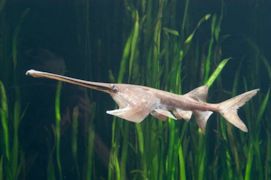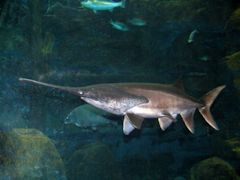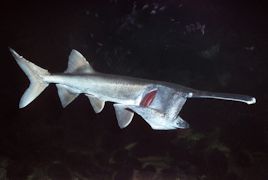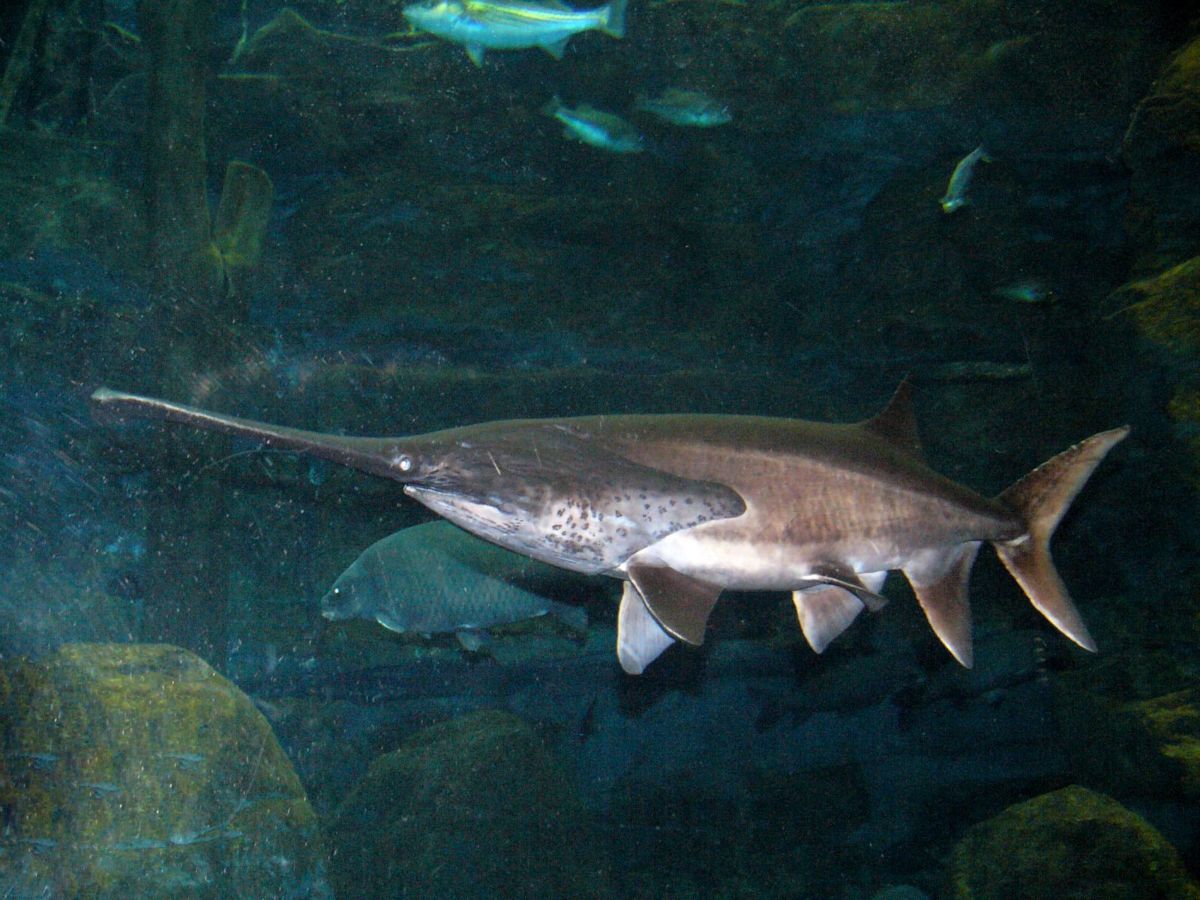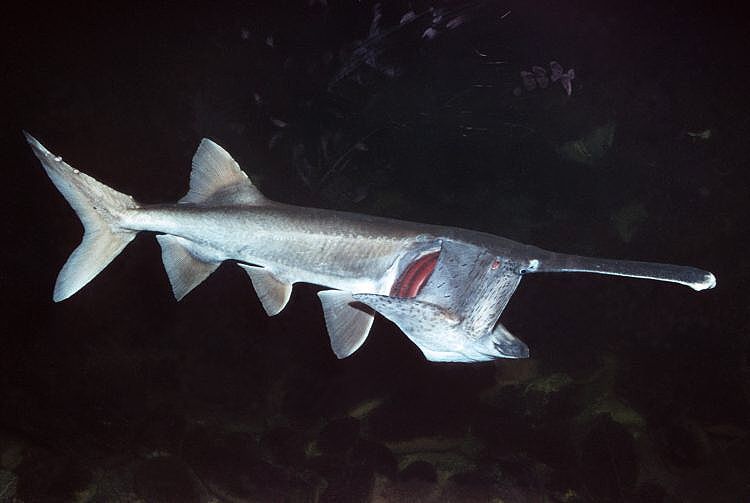Sturgeons and Paddlefishes
Description
American paddlefish are closely related to sturgeons in the order Acipenseriformes, an order of basal ray-finned fishes that includes sturgeon and paddlefish, several species of which are now extinct. The color of the paddlefish is slate-gray to gray-blue above, fading to somewhat lighter beneath. They can be easily distinguished from all other Iowa fishes by the immensely elongated snout, extremely long gill covers and shark-like mouth. The skeleton is largely cartilaginous. Jaws and palate of young specimens are covered with numerous fine teeth, but the jaws become large, feeble and toothless as the fish reaches maturity. The body is naked, or scale less. Paddlefish are in many respects one of the most primitive of fishes but are highly specialized in others. It is a remnant of ancient life, differing from other fishes by its elongated paddle like snout, long gill covers and shark-like body form. It was formerly abundant in the Mississippi valley, but over-exploitation, changes in environmental conditions, or both, have reduced its numbers to a point where it is no longer common except in certain places along the river.
Habitat
Paddlefish live mostly in open waters of big rivers, swimming continuously near the surface, and likely don’t have a specific home range. As waters rise in spring, paddlefish move upstream to gravel bars to spawn. Because they need lots of open, free-flowing rivers plus oxbows and backwaters for feeding and gravel bars for spawning, paddlefish numbers have declined with stream channelization, levee construction and drainage of bottomlands. Overharvesting has also contributed to their decline.
Range
American paddlefish are native to the Mississippi River basin and once moved freely under the relatively natural, unaltered conditions that existed prior to the early 1900s. They commonly inhabited large, free-flowing rivers, braided channels, backwaters, and oxbow lakes throughout the Mississippi River drainage basin, and adjacent Gulf drainages. Their peripheral range extended into the Great Lakes, with occurrences in Lake Huron and Lake Helen in Canada until about 90 years ago.[2] American paddlefish populations have declined dramatically primarily because of overfishing, habitat destruction, and pollution. Poaching has also been a contributing factor to their decline and will continue to be as long as the demand for caviar remains strong. Naturally occurring American paddlefish populations have been extirpated from most of their peripheral range, as well as from New York, Maryland, Virginia, and Pennsylvania. The current range of American paddlefish has been reduced to the Mississippi and Missouri River tributaries and Mobile Bay drainage basin. They are currently found in twenty-two states in the U.S., and those populations are protected under state, federal and international laws.
Discussion
The large size and bizarre shape have made paddlefish particularly interesting to the layman and scientist alike. Specimens over six feet long have been taken, placing it at or near the top of the list for "big fish" honors. Early growth of paddlefish is rapid with the fish reaching 10 to 14 and 21 to 24 inches in their second and third years of life. Seventeen-year-old fish average nearly 60 inches in length and weigh about 37 pounds. Paddlefish are long-lived fish with 20 years being common and 30 years or more not unusual. The larger individual fish are females. American paddlefish are closely related to sturgeons in the order Acipenseriformes, an order of basal ray-finned fishes that includes sturgeon and paddlefish, several species of which are now extinct. Paddlefish are among the oldest of fishes as evidenced in the fossil record which dates their first appearance approximately 300 to 400 million years ago, almost 50 million years before the dinosaurs. Fossil paddlefishes with recognizable rostrums date from the Upper Cretaceous and Paleocene periods 65 million years ago. An elongated rostrum is a morphological characteristic of Polyodontidae, but only the genus Polyodon (P. spathula and the extinct P. tuberculata) have characteristics adapted specifically for filter feeding, including the jaw, gill arches, and cranium. The gill rakers of American paddlefish are composed of extensive comb-like filaments believed to have inspired the etymology of the genus name, Polyodon, a Greek compound word meaning "many toothed". Adult American paddlefish are actually toothless, although numerous small teeth less than 1 mm (0.039 in) were found in a juvenile paddlefish measuring 630 mm (25 in). Spathula references the elongated, paddle shaped snout or rostrum. Compared to Chinese paddlefish and fossil genera, American paddlefish (and by extension, a fossil relative, P. tuberculata) are considered to be a highly derived species because of their novel adaptations.

